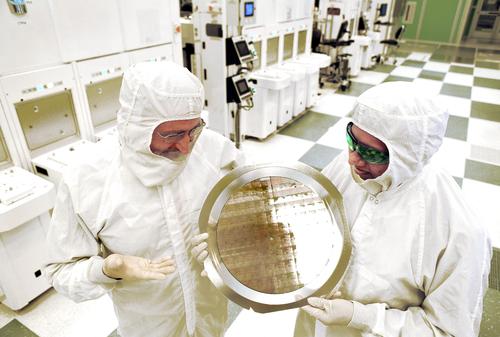Design News: IBM Gives Moore's Law a Boost with Innovative
Ultradense Chip

Ask chip manufactures and Moore's Law has been looking more and more like a theory with each passing year. But IBM has just revealed a prototype of an "ultradense" computer chips that the company says has four time the capacity of the most powerful chips on the market.
As The New York Times reported, if successfully adapted for mass production, IBM's new chip, developed in conjunction with SUNY Polytechnic Institute's Colleges of Nanoscience and Engineering as well as partners including GlobalFoundries and Samsung, would perpetuate Moore's Law and ensure computer chips continue to reduce the area needed for transistors by 50 percent up through 2018.
[caption id="" align="aligncenter" width="500"]
 Dr. Michael Liehr (left) of SUNY Polytechnic Institute's Colleges of
Nanoscale Science and Engineering and Bala Haran (right) of IBM
Research inspect a wafer comprised of 7nm (nanometer) node test
chips in a clean room in Albany, NY. (Source: IBM
Research)[/caption]
Dr. Michael Liehr (left) of SUNY Polytechnic Institute's Colleges of
Nanoscale Science and Engineering and Bala Haran (right) of IBM
Research inspect a wafer comprised of 7nm (nanometer) node test
chips in a clean room in Albany, NY. (Source: IBM
Research)[/caption]
"By making the chips inside computers more powerful and more efficient, IBM and our partners will be able to produce the next generations of servers and storage systems for cloud computing, big data analytics, and cognitive computing." Mukesh Khare, VP, IBM Semiconductor Technology Research, wrote in a blog post.
The key to IBM's breakthrough lies in both the material used and the production process. Rather than being made entirely of pure silicon, IBM researchers used silicon-germanium (SiGe) to make key regions of the chip's switches. IBM has been manufacturing SiGe-based chips since the late '90s, touting the alloy for its high speeds and low power consumption. Combining SiGe with extreme ultraviolet (EUV) light, IBM was able to etch patterns on chips that allowed the transistors to be a mere 7 nanometers in diameter. By comparison, within the next year, traditional chip manufacturing is expected to go down to 10 nanometers from the current level of 14 nanometers.

